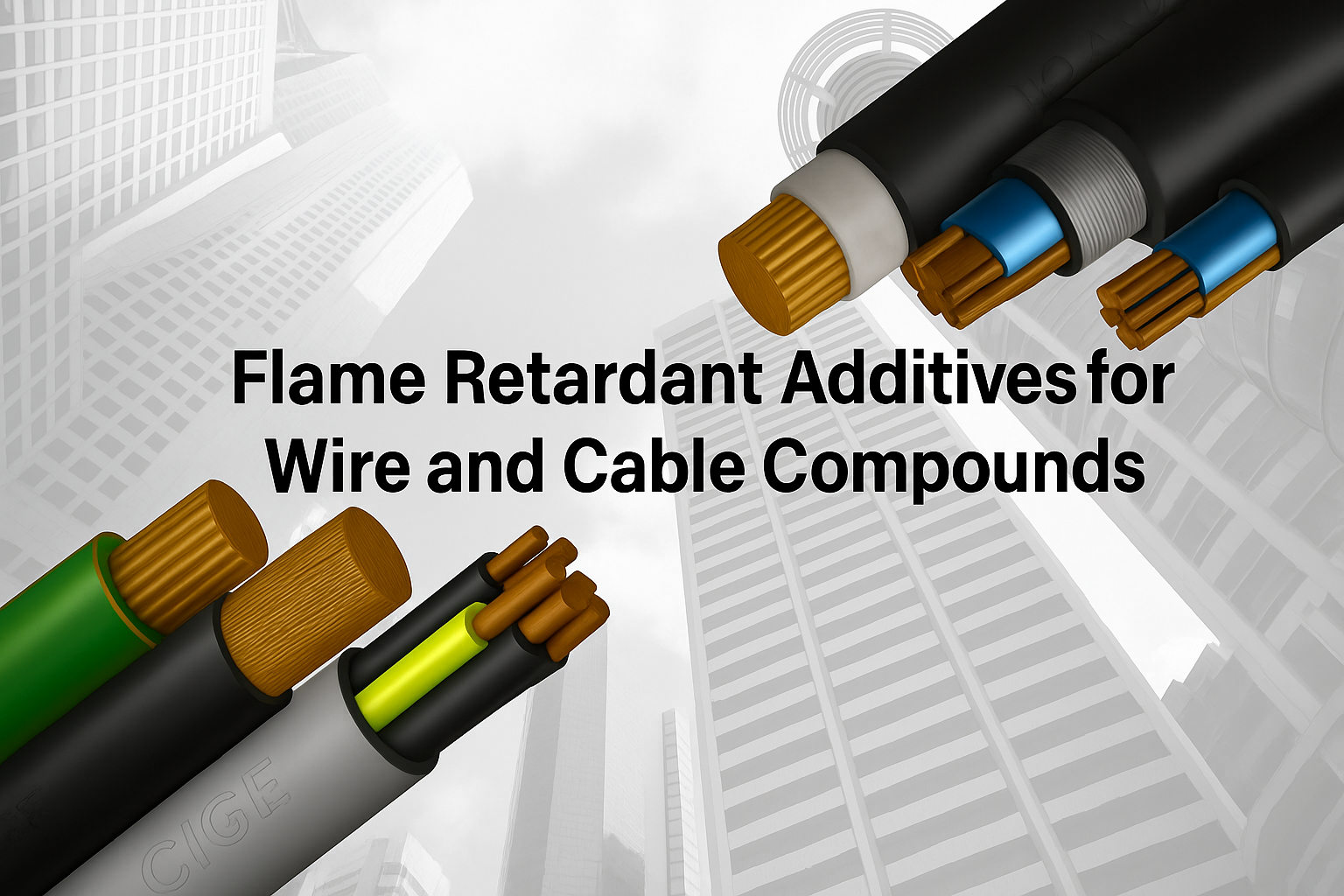Flame Retardant Additives for Wire and Cable Compounds
Worried your cable jackets fuel fires and release toxic smoke? Flame retardant additives stop that before it starts.
These additives protect cable insulation and jackets by slowing ignition, reducing flame spread, and cutting smoke and acid gas emission. They’re essential for fire safety compliance and protecting lives, equipment, and infrastructure.
In this article, I’ll cover the main categories of flame retardant additives used in cable compounds and explain the industry standards that verify their performance.
Categories of Flame Retardant Additives for Cable Materials
Choosing the wrong additive results in failed burn tests or brittle cables. Here's how to match flame retardant chemistry to your cable compound type, processing conditions, and compliance targets.
1. Halogenated Flame Retardants
- Mechanism: Halogen radicals (HCl, HBr) neutralize flame radicals (OH·, H·), breaking the combustion cycle.
- Examples: DecaBDE, HBCD, TBBPA.
- Advantages: Low loading (5–15%), high efficiency, excellent compatibility with PVC.
- Limitations: Corrosive smoke, regulatory phase-out (RoHS, REACH).
Best suited for low-cost compounds where toxic smoke is not a concern.
2. Halogen-Free Mineral Fillers
- Main Types: ATH (Aluminum Trihydrate), MDH (Magnesium Hydroxide).
- Mechanism: Endothermic decomposition absorbs heat and releases water vapor. Residual oxide acts as thermal barrier.
- Loading: High (40–70%) for effective performance.
- Applications: LSZH cable jacketing, EVA, PE, and PP base systems.
| Filler | Decomposition Temp | Heat Absorption (kJ/g) | Key Features |
|---|---|---|---|
| ATH | ~180 °C | 1.17 | Non-toxic, cost-effective |
| MDH | ~320 °C | 1.29 | Higher heat resistance |
Ideal for low smoke, halogen-free cables like those in public buildings, tunnels, or transit.
3. Phosphorus-Based Flame Retardants
- Gas Phase: Releases PO· radicals that inhibit flame propagation.
- Condensed Phase: Promotes charring via polyphosphoric acid formation.
- Common Types: APP, red phosphorus, RDP, TPP.
- Loadings: Moderate (10–30%) with better smoke suppression than halogenated systems.
Combine with synergists like melamine cyanurate or nanoclays for enhanced char formation.
4. Synergistic Flame Retardant Systems
- Why Combine?: Multiple additives improve performance and reduce overall filler loading.
- Examples:
- Phosphorus + ATH → better char + smoke reduction
- APP + Melamine → strong intumescence
- Silicone additives → glassy residue, enhanced surface insulation
- Nanofillers (e.g., graphene oxide, silicates) → reinforce char, improve mechanicals
| System | Typical Load | Benefit |
|---|---|---|
| Phosphorus + ATH | 20–50% | Lower smoke, thinner jacket |
| APP + Melamine | 15–30% | Intumescent barrier |
| Nanoclay + FR | 1–5% | Char strength, lower toxicity |
Key Standards and Flame Tests for Cable Compounds
Even if your additive performs in the lab, it must pass full-scale tests. These standards simulate real-world fire scenarios for wires and cables.
IEC 60332 – Flame Spread
- IEC 60332-1: Single vertical cable burn; flame must not exceed 425 mm.
- IEC 60332-3: Bundled cable burn; stricter spread limits.
Mandatory for all power, control, and telecom cables in public and commercial buildings.
UL 1581 VW-1 / FT1 / FT2 – Vertical Flame Tests
- Expose cable to flame for multiple 15-second cycles.
- Pass if flame self-extinguishes and no flaming drips occur within 60 seconds.
Especially used for appliance leads and flexible wires in North America.
IEC 61034 – Smoke Density
- Test Box: Cable burned in sealed chamber, optical density of smoke measured.
- Pass: Light transmission ≥ 60%
Required for LSZH and CPR-rated cables.
IEC 60754 – Acid Gas and Halogen Content
- Part 1: Measures pH and conductivity of gases released.
- Part 2: Measures halogen acid gas content by weight.
| Requirement | Limit |
|---|---|
| pH | ≥ 4.3 |
| Conductivity | ≤ 10 µS/mm |
| Halogen Content | ≤ 0.5 wt% |
EN 45545-2 – Railway Cable Safety
- Used in Europe to classify hazard levels (HL1 to HL3)
- Evaluates flame spread, heat release, smoke density, toxicity, and corrosion
Other Standards
- NFPA 262 / 269: US tunnel and corner burn tests
- ISO 5659: Smoke and toxicity under controlled heat
- NFPA 701: Flammability of textiles and flexible materials
| Test Standard | Focus | Relevance |
|---|---|---|
| IEC 60332-1/-3 | Flame spread | General cable use |
| UL VW-1 / FT1 | Vertical flame + no drip | Appliance, flexible leads |
| IEC 61034 | Smoke density | LSZH, transit cables |
| IEC 60754-1/-2 | Acid/halogen content | CPR, building code |
| EN 45545 | Heat/smoke/toxicity | Rail and mass transit |
Practical Takeaways from Formulation Trials
In my extrusion lab, we once swapped ATH with a phosphorus-organic blend in a thermoplastic halogen-free jacket. The result:
- Flame performance: passed UL VW-1, IEC 60332-1
- Smoke: 40% lower optical density
- Compound cost: reduced by 12% (less filler)
- Process: smoother extrusion, thinner jacket wall
Key lesson: synergistic blends can outperform single-fill systems—and save cost.
Summary
Flame retardant additives are non-negotiable for wire and cable compounds—not just for compliance, but for real safety.
Choose based on:
- Smoke and acid gas limits
- Required flame spread resistance
- Mechanical, electrical, and processing needs
- Target test standard (IEC 60332, UL VW-1, etc.)
📌 Whether you’re formulating LSZH jackets, MV insulation, or appliance wiring, we can help.
👉 Contact us for sample formulations, TDS, or application recommendations.

